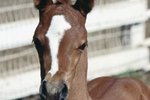Horses mate naturally in the wild but mating is often controlled and directed when humans are breeding their horses. Without human intervention, horses will breed in a mounted position after the males compete for female attention and acceptance. In a controlled environment, mating is attempted based on estrus cycles and the matching of pairs through human preference. Artificial insemination is also a possibility for breeding horses.
Estrus Cycles
The mare must enter estrus before she is prepared for breeding. The common estrus cycle occurs during the spring as the days become longer. Although the typical length of an estrus cycle is 20 days, the mare is most receptive to a mate during the first week of her cycle. After the first week, she becomes less likely to breed and conceive.
Artificial Estrus Triggers
Estrus is natural during the spring but artificial triggers are often used to send a mare into estrus at different times of the year. Horse breeders will keep a mare under lights in a barn to simulate longer days and send her into an estrus cycle. This helps breeders control the time of year they foal. The process is especially common in the horse racing world where maturing as a race horse is a time dependent process.
Mate Selection
In wild horse populations, a single male will show dominance and claim a band of females in estrus. Other males are forced to the outskirts where they will seek receptive females outside of the dominant band. Males may challenge for dominance but only one male will reproduce successfully within a single band. In domestic populations, horses are individually selected and paired for breeding. Dominance is not necessary and the pairs move directly into acts of courtship.
Courtship and Behavior
Once a stallion is paired with a dam in heat, they engage in acts of courtship. The dam will urinate and posture in a receptive position for the stallion. The stallion will responding according to his libido. Some stallions are slow to accept the process and others are uncontrollably aggressive. The stallion will raise his muzzle and flare his lips to indicate a willingness to mate. When the pair is ready, they will engage in intercourse.
References
- Extension: Horse Breeding Behavior by Ashley Griffin
- University of PENN: Reproductive Behavior of the Stallion by Sue Mcdonnell
Photo Credits
-
Image Source White/Image Source/Getty Images
Writer Bio
Zach Lazzari is a Montana based freelance outdoor writer and photographer. You can follow his work at bustedoarlock.com.




